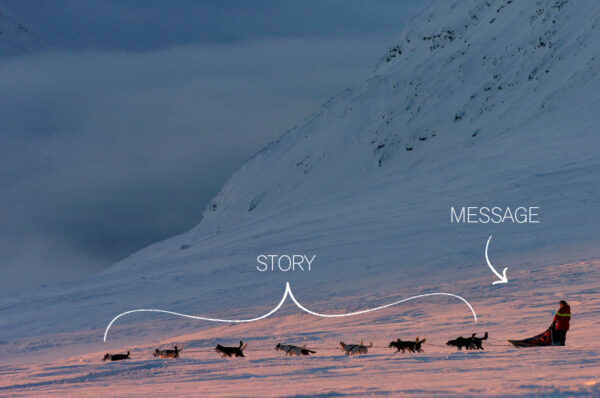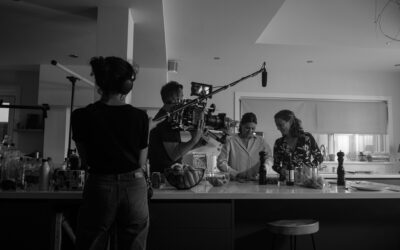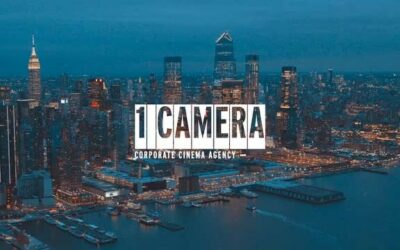I’ve been making corporate film for fourteen years, and I still make a point of keeping my eye out for beautifully told stories in corporate communication. Because, like anyone else, I really enjoy a good, well-told story. But I have to be honest here: big corporate (marketing) communication campaigns that use storytelling in an emotionally compelling way – campaigns that touch hearts – are rare compared to those that are not emotionally compelling at all. Why is this? And what can we learn from their mistakes? In two blog posts, I will share some of my insights with you and how we applied those insights in a new corporate film we made for insurance company Achmea.
In this first post I will talk about the relationship between story, insight, and message. The second article will explain how a persistent phenomenon called ‘negaphobia’ – fear of the negative – greatly diminishes the potential impact of corporate storytelling.
The challenge of corporate storytelling
So, why does most corporate storytelling fail? It’s not that we don’t all understand what storytelling is – we recognise a great story immediately. A great story is about real people, people who struggle, who must overcome obstacles to achieve their goals. And we, as viewers, get to travel with them on their journey to failure or success. A great story is eventful, surprising, touching, relatable. Sounds straight forward, right?
Well, not if you also have to bring a corporate message across. In my experience, communications professionals love the idea of corporate storytelling, until I tell them that to be successful, their corporate message shouldn’t be the focus of the story – the story should lead the viewer towards their message. That’s of course the opposite of what we’ve all been taught to do: traditional corporate communication insists you repeat your message and your brand wherever you can. Message. Message. Message. As a result, many managers understandably ask themselves: “Why would I want to spend money on a film that doesn’t show my message and brand in every frame?” To them, I show this film:
It’s one of the most effective examples of corporate storytelling I know. It’s worth studying, because the general structure of this commercial is a good example of what makes storytelling such a great corporate communication tool – if used properly. Take another example, this one made by us at 1Camera:
These two films tell different stories: they vary in characters, storylines, and locations. But the films have a similar structure. They start with a powerful story that doesn’t mention the company’s name, provide the viewer with an insight, and follow it up with the company’s message. And as you can experience yourself, the results are powerful. These are the types of commercials and corporates your audience will remember.
That is no accident. They are designed to do that, namely like this:
In short: story, story, story, story, story, story, story, story. And then the message.

A feeling of connection
This is the general structure of both examples in a nutshell:

As you can see, the first 80% of the film is used to tell the actual story. This story should be designed to take a viewer on an emotionally charged journey, a story about real people the viewer can relate to. Because the goal is to touch. To get the viewer to a place where they feel this film is about them. To establish a genuine feeling of connection between the viewer and the people in your film and to make that connection meaningful, through emotions.
The second part is the insight that follows from the story. This brings the theme of the film in full focus. In the first example from P&G, the insight is “The hardest job in the world, is the best one” followed by “Thank you, Mom.” These phrases condense the different storylines into a coherent and compact statement that encapsulates the theme of the film in an inspirational, emotionally charged way. For DSM’s Unsung Heroes it’s: “Never doubt that a few caring scientists can change the world.”
The third part is the corporate message. In our DSM film, it’s the marriage of the idea that ‘science can change the world’ and DSM’s brand promise “bright science, brighter living”, and in the case of P&G this final part contains a campaign tagline that emphasizes the connection between the insight the viewer has earned and the message the company wants to convey: “Proud sponsor of Moms”. The goal of this last part is to associate the emotionally charged insight with the brand.
The last part is of course the company’s logo and/or corporate pay-off, sometimes combined with a call to action, URL or social media handles.
Although all this may seem straightforward, the challenges in creating a film as powerful as these two examples can be immense – unless the process is guided properly. Let me tell you our secret.
Work our way back: The Achmea case
The way we at 1Camera approach the process of developing a powerful piece of corporate storytelling like the examples above is by starting at the end and working our way back. Finding out with the client what message the film should end on and then find a story that leads the viewer there. Let’s take the new Achmea corporate film we made as an example:
So, starting at the end, we firstly had to find not only the message Achmea wanted to convey, but also the insight that makes the message relatable and relevant to the audience. Finding this insight was the result of a deep dive into Achmea’s corporate culture. This meant speaking to the company’s staff, their CEO, and diving into their culture and history. In this extensive research process, we were not looking for trivial stuff. We wanted to find out what Achmea stands for. What they truly believe in and, perhaps most importantly, what their meaning is to the world around them. Those values are the springboard to find out what the insight and message should be to end the film on. The insight we drew during our concept development was that the value of an insurance system is that it promotes solidarity and creates continuity.
Only when we figured out that insight and message, we started designing a narrative structure – the five storylines – that would convey those values of solidarity and continuity and logically lead the viewer to the insight and message. A great way to find such a narrative structure is to look at the opposite or absence of the values that your insight revolves around. So in the case of Achmea, the absence of solidarity and the opposite of continuity. By making the audience feel ‘loneliness’ and ‘life coming to a halt’, we supercharge the emotional impact of the insight.
The final step to storytelling is not to come up with a story, but to find a story. That’s why, after lining up the message, the insights and the themes of the story, we started ‘story mining’ research to find actual stories that illustrate this dynamic of solidarity sparking continuity. Out of close to a hundred stories, we selected the most powerful ones that were relevant to Achmea’s insurance portfolio, to land on a list of five stories that represented not only the message, but also the different brands and sectors of the insurance cooperative Achmea.
Perfect alignment
That balance is crucial. When you watch a corporate film that uses storytelling techniques effectively, it’s tempting to think the film works just because the story is great and the film is well acted and shot. But in reality, it’s the perfect alignment of story, insight and message that makes it work. If one of those three elements is off – the brand doesn’t fit the message, or the story doesn’t express the values embedded in the insight – you get a film that may work as a stand-alone story, but not as a commercial or corporate film. Look at this next video, from Vodafone. A powerful story combined with a great insight, but ending on a forced and unconvincing connection with the company’s message. A huge missed opportunity.
That’s a perfect example to illustrate the challenges of effective corporate storytelling. But when you get it right, the rewards are huge. Unsung Heroes had a global reach with millions of views, and Thank You, Mom was the biggest and most successful global campaign in P&G’s 175-year history with $500 million in global incremental sales, and over 74,000,000 global views. On top of that, it also did something else: it brought a positively charged emotional message into the world and brought joy to millions of people worldwide. Everybody wins.
In the next post, I will delve more into the making of our corporate film for Achmea, and explain what’s positive about being negative.


